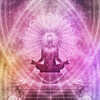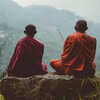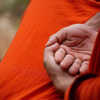
Today, yoga has become synonymous with wellness — sleek studios, Instagram-friendly poses, and lifestyle influencers recommending it as a daily ritual. But yoga, in its truest form, is far more than a flexibility practice or a fitness routine. Its roots stretch deep into the spiritual and philosophical soil of ancient India, where it was born not for bodily fitness, but for inner transformation.
This article journeys back to where it all began — to the sages, scriptures, and silent forests of ancient India — to rediscover the profound origins of yoga and why it still holds meaning in our noisy, modern lives.
The Word ‘Yoga’: What It Truly Means

The word ‘Yoga’ comes from the Sanskrit root ‘Yuj’, which means to yoke or to unite. But this union is not just of body and breath — it’s about joining the individual consciousness with the universal consciousness. Simply put, yoga is the path to realizing our interconnectedness with the cosmos.
It wasn’t originally designed to flatten your abs or fix your posture. It was created to still the mind, transcend suffering, and reach Moksha — liberation from the cycle of birth and rebirth.
Yoga in the Vedas: The First Footprints

The earliest mention of yoga is found in the Rig Veda, one of the oldest texts known to humankind, dated around 1500 BCE or earlier. The Vedas were not instruction manuals for physical exercises, but sacred hymns recited by rishis (sages) in meditative states. Within these chants lies the philosophical seed of yoga — the longing for union with the divine.
While the term ‘yoga’ as a practice wasn’t fully fleshed out in the Vedas, the spirit of yoga — self-discipline, ritual, introspection — was already there. The focus was more on tapas (spiritual heat or effort) and communion with higher realms through mantra and fire sacrifices.
Upanishads: Inner Yoga and Mysticism

As Indian spiritual thought evolved, the Upanishads — philosophical commentaries on the Vedas — brought yoga closer to what we recognize today. These texts, composed between 800 and 400 BCE, turned attention from outer rituals to inner experience.
In the Katha Upanishad, yoga is described as the steady control of the senses and mind, where the soul realizes its true nature. Here, yoga starts being seen as a discipline of both body and mind, emphasizing stillness, self-awareness, and meditative absorption.
The Shvetashvatara Upanishad even mentions postures and breath control — an early nod to what would later evolve into Hatha Yoga.
Mahabharata and the Bhagavad Gita: Yoga in Action

One of the most accessible and transformative texts for understanding yoga is the Bhagavad Gita, which appears within the epic Mahabharata.
In the Gita, Lord Krishna explains to the warrior Arjuna various paths of yoga — Karma Yoga (yoga of action), Bhakti Yoga (devotion), and Jnana Yoga (knowledge). These are not just paths to liberation but models for how one can live a spiritual life within the world, not outside it.
The Gita’s message? You don’t have to renounce the world to walk the yogic path. Yoga is about how you live, not where you live.
Patanjali’s Yoga Sutras: The Manual of the Mind

While yoga had many scattered references, it was the sage Patanjali who systematized it around 200 BCE into a coherent philosophy with his Yoga Sutras. This text remains the cornerstone of classical yoga theory.
Patanjali outlined the Ashtanga Yoga system — the Eight Limbs of Yoga — which include:
1. Yama (ethical restraints)
2. Niyama (personal observances)
3. Asana (physical posture)
4. Pranayama (breath control)
5. Pratyahara (withdrawal of senses)
6. Dharana (concentration)
7. Dhyana (meditation)
8. Samadhi (absorption or bliss)
Interestingly, asana — the physical posture — is just one step in this spiritual ladder. In modern yoga, we often start and stop at asanas, but Patanjali saw them as a mere tool to prepare the body for long periods of meditation.
His teachings show that yoga is more about the mind than muscles.
The Rise of Hatha Yoga: Body as the Temple

By the 9th to 15th centuries, India saw the rise of Hatha Yoga, a more physical and body-oriented approach to spiritual practice. This was influenced by the Tantra tradition, which emphasized using the body — rather than renouncing it — as a means to enlightenment.
Texts like the Hatha Yoga Pradipika and Gheranda Samhita introduced detailed instructions on poses (asanas), breathing techniques (pranayama), and even internal cleansing methods (shatkarmas). These practices were not for show — they were designed to awaken dormant energy (Kundalini) and purify the channels (nadis) of the body.
Yoga’s Decline and Revival

With centuries of invasions and colonial rule, many traditional Indian practices, including yoga, went underground. However, by the late 19th and early 20th centuries, there was a revival — thanks to Indian spiritual leaders who saw yoga as a path not just to personal freedom but to national pride.
Figures like Swami Vivekananda introduced the West to Raja Yoga in the late 1800s, focusing on meditation and mind control rather than physical poses.
Later, teachers like T. Krishnamacharya, B.K.S. Iyengar, Pattabhi Jois, and Paramahansa Yogananda brought different forms of yoga to the global stage. Their efforts ensured yoga wasn't lost in textbooks but lived through practice.
Yoga Today: From Ashrams to Airports

Today, yoga is a multi-billion-dollar industry. It’s taught in schools, hospitals, gyms, and yes — even airports. While its mainstream appeal is undeniable, it has also sparked concerns of cultural appropriation and dilution of its original intent.
The International Day of Yoga, observed annually on June 21 since 2015, was proposed by India to recognize yoga’s global importance and cultural roots. It's a reminder that while yoga may be global now, its heart still beats in the soil of Bharat.
Returning to the Source

Yoga, at its core, is a path — one that invites us to go inward, to question, to still our breath and thoughts, and to connect with something larger than ourselves. It was born not in air-conditioned studios but in the stillness of ancient forests, in the hearts of sages who sought meaning beyond material life.
In a world of distraction, yoga remains a quiet rebellion — an ancient whisper in a noisy room.
As we roll out our mats and stretch into downward dog, perhaps the real yoga begins when we close our eyes, take a conscious breath, and remember that this practice is more than poses — it’s a sacred legacy.
Unlock insightful tips and inspiration on personal growth, productivity, and well-being. Stay motivated and updated with the latest at My Life XP.
 Today, yoga has become synonymous with wellness — sleek studios, Instagram-friendly poses, and lifestyle influencers recommending it as a daily ritual. But yoga, in its truest form, is far more than a flexibility practice or a fitness routine. Its roots stretch deep into the spiritual and philosophical soil of ancient India, where it was born not for bodily fitness, but for inner transformation.
Today, yoga has become synonymous with wellness — sleek studios, Instagram-friendly poses, and lifestyle influencers recommending it as a daily ritual. But yoga, in its truest form, is far more than a flexibility practice or a fitness routine. Its roots stretch deep into the spiritual and philosophical soil of ancient India, where it was born not for bodily fitness, but for inner transformation.



 One of the most accessible and transformative texts for understanding yoga is the Bhagavad Gita, which appears within the epic Mahabharata.
One of the most accessible and transformative texts for understanding yoga is the Bhagavad Gita, which appears within the epic Mahabharata.




